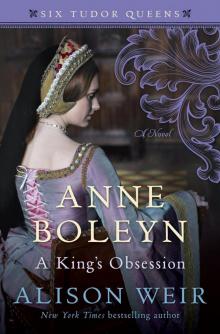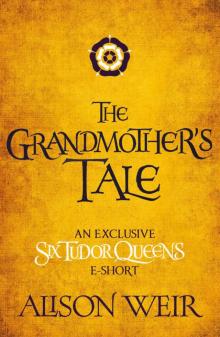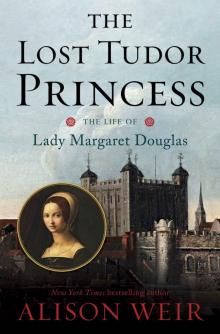- Home
- Alison Weir
Wars of the Roses Page 2
Wars of the Roses Read online
Page 2
As today, there were local variations in dialect, but in the fifteenth century these differed so much that even Kentishmen and Londoners had trouble understanding each other. Society was insular and localised and people referred to the county or shire in which they lived as their ‘country’; people in other ‘countries’ were regarded as foreigners.
Most travellers from abroad commented on the alabaster beauty and charm of Englishwomen, and many were amazed by their forwardness. One Bohemian visitor, Nicholas von Poppelau, discovered that they were ‘like devils once their desires were aroused’. He and others were enchanted, however, with the English custom of kissing on the mouth on greeting: ‘To take a kiss in England is the equivalent of shaking hands elsewhere.’
In the fifteenth century Western Europe regarded itself as a united entity bonded by a universal Catholic Church and the philosophy of a divinely ordered universe. Late mediaeval man held a deep-rooted belief that society was also ordered by God for the good of humanity, and this concept of order expressed itself in a pyramidical hierarchy that had God enthroned at the summit, kings immediately beneath Him, then – in descending order – the nobility and princes of the Church, the knights and gentry, the legal and professional classes, merchants and yeomen, and at the bottom the great mass of peasants. Each man was born to his degree, and a happy man was one who did not question his place in life.
God’s law was the natural law of the universe, as revealed in the Scriptures and in the divinely inspired canon and civil law of Church and State. Authority derived from God was sacrosanct. Peace and order could only be achieved when all classes of society were in harmony with each other. Disorder – such as heresy, rebellion, or trying to get above one’s station in life – was regarded as the work of the Devil and therefore as mortal sin. It was held that one of the chief duties of a king was to ensure that each of his liege men lived in the degree to which he was born. Sumptuary laws passed during the period regulating dress and behaviour were intended to preserve order in society; that they were necessary is evidence that already some traditional ideals were being challenged.
By the late fourteenth century the structure of English feudal society was showing signs of crumbling as a result of the social revolution engendered by the Black Death. In the fifteenth century the unity of Christendom was undermined by a decline in respect for the papacy and the Church and by a burgeoning nationalism in the countries of Western Europe. Men were also questioning the old concept of order in society. In 1381, the leaders of the Peasants’ Revolt had asked: ‘When Adam delved and Eve span, who was then the gentleman?’ In the following century a new materialism fostered by trade and private enterprise gave birth to the beginnings of capitalism, just as the old land-based economy was changing in response to economic demands.
Change did not take place overnight. The order imposed upon society by Church and State was still a potent force in the fifteenth century. The English Church was then part of the ‘Christian Republic’ of Catholic Europe, and was subject to papal laws and taxes. However, the princes of the Church enjoyed less power than in former centuries, and were gradually giving place to the magnates as a result of the increasing secularisation of government. The power of the bishops was more of a judicial than a spiritual nature, and many enjoyed a luxurious existence which was increasingly perceived as being at variance with the example set by Jesus Christ.
The fifteenth century was a time of stark contrasts within the English Church. On the one hand there was an escalating interest in sermons, homilies, pious moralising and mysticism, while on the other the heretic Lollards, inspired by the teachings of John Wycliffe, were attacking abuses in the Church and even questioning its authority in spiritual matters. Lollardy appealed to the poorer classes of society, but was so ruthlessly suppressed by successive kings that in most areas its influence became negligible.
Growing anti-clerical sentiment meant that the clergy were not immune to the general lawlessness of the age, and many cases of violence against men in holy orders were brought before the courts.
Religious faith was still as lively and deep-seated as ever. England boasted thousands of parish churches and was not for nothing known as ‘the ringing isle’. There was a steady rise in the number of inmates of the monasteries and convents throughout the period, although there were few new foundations. However, chantries grew steadily in number. Pious folk would leave money in their wills to found chantry chapels in which priests would say masses in perpetuity for the salvation of the soul of the departed and his family. Some of these foundations were very large and comprised whole colleges of priests serving collegiate churches which housed several chantry endowments. Many parish churches were converted into such colleges and beautified accordingly.
The transitory nature of life on earth was an ever-recurring religious theme. Given the high rate of infant mortality and relatively low life expectancy, death was an accepted part of life. Men lived to an average of around fifty, with about one fifth surviving to their sixties. Women, as a result of the perils of childbearing, could only expect to live to an average of thirty, while it is possible that up to half of all children did not reach twenty. It was held that those who suffered in this world would receive their reward in Heaven. Death was the great leveller and all, kings and popes together with merchants and peasants, must one day be called to account before the seat of Judgement. The general preoccupation with death manifested itself in the pictures, literature and tomb sculpture of the time: the rich were sometimes buried in tombs with two effigies, the upper one showing the person as in life, nobly attired, while the lower one portrayed a rotting corpse, eaten by life-like worms.
Heaven was perceived as a magnificent and incorrupt royal court, to which the devout and godly would be admitted. Hell – as revealed in vivid Doom paintings on church walls – was an ever-present and very real deterrent to sinners.
People believed that the hand of God directed and guided the affairs of princes. There was also a firm conviction that God bestowed victory in battle to vindicate the right of the victor. A king was the Lord’s anointed, hallowed at his coronation with holy oil. His chief functions were to protect his people by defending them against their enemies, to govern with justice and mercy, and to preserve and enforce the law of the land. ‘To fight and to judge are the office of a king,’ wrote Lord Chief Justice Sir John Fortescue in the 1460s. The qualities required were courage, wisdom and integrity, and the character of the sovereign was therefore all-important and on it depended the security and well-being of his subjects. Late mediaeval monarchy was a highly personal system of government: in this period kings ruled as well as reigned, and they wielded vast power.
Over the centuries, however, the administration of government had become increasingly cumbersome, and kings had delegated more and more of it to the growing number of departments of state within the royal household. These all carried out their particular functions in the king’s name while the monarch retained direct responsibility for foreign policy, the exercise of the royal prerogative and patronage, and control of the nobility. Kings were in theory at liberty to do as they pleased, but it was widely recognised that this ‘liberty’ was bound by the constraints of law and justice. The king’s ‘grace’ enabled him to adopt new ideas while preserving the ancient customs and traditions of the realm. The kingdom of England was regarded as the property of the monarch but, as Fortescue pointed out, although the royal power was supreme, kings could not make laws or impose taxes without the consent of Parliament.
A king was not only expected to protect and defend his realm but also had to be seen as a competent warrior. A king who inclined towards peace courted adverse public opinion, for most people placed great value on success in arms and the glorification of the nation’s reputation.
English kings of the fifteenth century did not maintain a standing army but relied on their nobility to provide them with troops when necessary. Hence it was important for a monarch to maintain good relat
ions with the aristocracy and gentry, who might, if sufficiently provoked, use the armed strength at their disposal against him. It was also the duty of the sovereign to prevent power struggles between magnates, especially where these affected the stability of the realm. As we shall see, failure to do this could lead to dire consequences.
The people and ‘common weal’ of the realm were dependent on the monarchy producing heirs who were fit and able to rule and who could command the respect and loyalty of their subjects. Above all, a king’s title to the throne had to be beyond dispute, for this could and did lead to civil war, with all its attendant horrors. Thanks to the Wars of the Roses, by the end of the period covered by this book a king’s title to the throne had come not to matter as much as his ability to hold on to that throne and to govern effectively. In the late mediaeval period the law of succession to the throne was ill-defined. Generally, primogeniture – the succession of the eldest son and his heirs – was the rule, but there were other important elements involved, such as recognition by the lords spiritual and temporal and, later, the ability to provide stable government.
Since the twelfth century, when Matilda, daughter of Henry I, had made a disastrous attempt to wrest the crown from her cousin, King Stephen, the English had been averse to the idea of a female ruler, believing that the concept was against nature and that women were incapable of good government. However, the law of the Salic Franks, which barred succession through a female, did not apply in England, where there was no statutory bar to a woman succeeding to the throne or transmitting a claim to her descendants. In fact, the issue had never been put to the test because, until the fifteenth century, the House of Plantagenet had produced a sufficiency of male heirs.
Apart from their distrust of female rulers, the English also feared the political instability of minorities, which occurred on the thankfully rare occasions when a child succeeded to the throne. Prior to the accession of Richard II in 1377 there had been only two minorities since the Norman Conquest of 1066; both had witnessed political turmoil.
From 1399 to 1499 the crown became the object of feuds, wars and conspiracies, not because of a dearth of heirs, but because there were too many powerful magnates with a claim to the throne. During this period a new and disturbing element became involved in determining the royal succession: the prevalence of might over right. This brought a new awareness of the lack of statute law governing the succession and a debate as to whether the rights of a senior heir general, with a claim transmitted through a female, could take precedence over the rights of a junior heir male. But in the final analysis strength and success were what counted: an effective ruler was more likely to remain on the throne, however dubious his title. Weak or tyrannical rulers met with disaster.
During the fifteenth century some attempts were made to regulate the laws of succession, but the highest legal authorities in the land, fearful of reprisals from interested magnates, repeatedly refused to pronounce conclusively on so weighty a matter, saying that the issue could not be determined by reference to common law.
The Wars of the Roses were primarily wars between the great magnates. The magnate class consisted of a small number of dukes – usually related to the royal house – marquesses and earls, and a great number of barons, knights and gentry. These were the men who owned most of the landed wealth of the kingdom and who exercised the greatest influence in their own territories, where they were respected and often feared.
John Russell, Bishop of Lincoln and Lord Chancellor in the 1480s, looked upon the English nobility as the rock and firm ground in a storm-tossed sea. Upon their shoulders lay the responsibility for the government of England. The nobility looked to the crown for promotion and rewards in return for services rendered in politics, in the field of battle, in the administrative departments of the royal household, in the diplomatic service, or in local government.
Rank was everything. During the Wars of the Roses, experienced commanders deferred to teenage boys simply because the latter were of the blood royal. The higher the rank, the richer the lord. A great magnate such as the Duke of York enjoyed an annual income of above £3000.* A baron could expect around £700 per annum, a knight anything between £40 and £200. The cost of building a defensive castle, such as Caister in Norfolk, was in the region of £6000.
From the fourteenth century onwards, the number of magnates had diminished. Wars, plagues, feuds and tournaments had led to many male lines dying out. Titles were frequently transferred via the marriages of heiresses, and inheritances grew consequently larger. By the fifteenth century the magnates, though fewer in number, had wider lands, greater wealth, and more power than ever before. Very few of the old Anglo-Norman families were left, but prominent families of the period – the Montacutes of Salisbury, the Courtenays of Devon, the Percies of Northumberland, the Nevilles, FitzAlans, Beauchamps, Staffords and Mortimers – were descendants of barons and knights, and were almost indistinguishable from this group, from which they frequently chose marriage partners. Many knightly families such as the Tiptofts and Bonvilles enjoyed substantial lands and influence, and would in the fifteenth century be elevated to the peerage. They would also look to increase their wealth by intermarrying with rich, mercantile families.
By the mid-century many of the great magnates were creating considerable wealth for themselves by investing in trade, while judicial marriage alliances were calculated to extend still further their lands and influence. Thus evolved what Lord Chief Justice Fortescue referred to as the ‘over-mighty subject’, who could command the loyalty and support of a huge army of tenants and retainers. Indeed, the prestige of a nobleman during the period came to be measured by the size of his private army and his ‘affinity’, those who were bound by contract to serve him.
By the reign of Henry VI (1422–61), feudalism had given way to what is often now described as ‘bastard feudalism’. Men of all classes had profited financially from the Hundred Years War with France, and when they returned home some used their profits to establish landed families. However, survival depended upon earning sufficient income to support such a lifestyle, and many men placed themselves under the protection of a powerful magnate, not as feudal vassals who swore allegiance to the lord and in return for his protection performed knight service when required, but as liveried retainers under contract. These contracts, or indentures, would bind both parties for a set period, often for life. The retainer became a member of the lord’s affinity, would wear his livery – a uniform and badge – and accompany him on military campaigns. In return, the magnate would assure the retainer of ‘good lordship’, which meant protection from his enemies and payment of an income known as a pension. The retainer could also expect rewards for services rendered, and these were often substantial, such as land or lucrative offices.
By means of this system, the wealthy magnates were able to gather around themselves affinities that could be used as formidable fighting forces. Without the existence of such private armies the Wars of the Roses could not have taken place.
Personal loyalty played little part in the new relationship between lord and retainer. A lord could only command a large following if he was rich, successful and influential. Self-interest, greed and the prospects of advancement were determining factors, ‘for the people’, wrote Fortescue, ‘will go with him that best may sustain and reward them’.
Bastard feudalism had its origins in the thirteenth century, but its growth had been facilitated by the decline of feudalism, the Hundred Years War, and the economic and social effects of the Black Death. By the end of the fourteenth century the government was already concerned about the effect this trend was having on the administration of justice at local level, and legislation was passed restricting the wearing of liveries. Up until the reign of Henry VI, however, the nobility were more preoccupied with the wars with France than with building up power bases at home. But by 1450 it was becoming alarmingly apparent that bastard feudalism was a threat, not only to local society, but also to the stabi
lity of central government itself. The private armies of noblemen were holding the countryside to ransom by bribery, extortion and violence, and subverting law and order by intimidation and threats, often with the backing of the great lords who employed them, whose duty it was to maintain the King’s peace. This led to a lessening of confidence in the judicial system. Justice, it seemed, was available only to those who could pay enough to secure a ‘right verdict’.
Fortescue warned of ‘the perils that may come to the King by over-mighty subjects. Certainly there may be no greater peril than to have a subject equivalent to himself.’ Some magnates were ‘of livelihood and power like a king’ already, and this did not augur well for the peace of the realm.
Some magnates were well-educated, cultivated men who carried out their duties conscientiously. Like all their caste, they were committed to the ideal of the triangular power structure presided over by the monarchy and to their time-honoured right to act as the king’s chief advisers. The fourteenth-century French chronicler Jean Froissart had praised the English nobility for being ‘extremely courteous, friendly and approachable’, but in the fifteenth century this was not always the case. Some were rough, violent men, whose brutish instincts were barely concealed by the trappings of chivalry. A few, like John Tiptoft, Earl of Worcester, were notorious sadists.
Many aristocrats lacked a sense of political responsibility. They were often at loggerheads with each other, or deeply divided by factional interests. Those in positions of the greatest power were frequently corrupt, avaricious and partisan, ruthlessly competing for royal patronage, jealously guarding their own interests and sparing little concern for those weaker than themselves. ‘The officers of the realm peeled the poor people and did many wrongs,’ wrote a chronicler in the 1450s.

 Richard III and the Princes in the Tower
Richard III and the Princes in the Tower Britain's Royal Families: The Complete Genealogy
Britain's Royal Families: The Complete Genealogy The Lady in the Tower: The Fall of Anne Boleyn
The Lady in the Tower: The Fall of Anne Boleyn Six Wives of Henry VIII
Six Wives of Henry VIII Elizabeth of York: A Tudor Queen and Her World
Elizabeth of York: A Tudor Queen and Her World Captive Queen
Captive Queen Innocent Traitor
Innocent Traitor The Marriage Game
The Marriage Game A Dangerous Inheritance
A Dangerous Inheritance Katherine of Aragón: The True Queen
Katherine of Aragón: The True Queen The Marriage Game: A Novel of Queen Elizabeth I
The Marriage Game: A Novel of Queen Elizabeth I Princes in the Tower
Princes in the Tower Anne Boleyn: A King's Obsession
Anne Boleyn: A King's Obsession Traitors of the Tower
Traitors of the Tower Mistress of the Monarchy: The Life of Katherine Swynford, Duchess of Lancaster
Mistress of the Monarchy: The Life of Katherine Swynford, Duchess of Lancaster Queens of the Conquest: England’s Medieval Queens
Queens of the Conquest: England’s Medieval Queens Eleanor of Aquitaine: A Life
Eleanor of Aquitaine: A Life Mary, Queen of Scots, and the Murder of Lord Darnley
Mary, Queen of Scots, and the Murder of Lord Darnley Henry VIII: The King and His Court
Henry VIII: The King and His Court Queen Isabella: Treachery, Adultery, and Murder in Medieval England
Queen Isabella: Treachery, Adultery, and Murder in Medieval England Katheryn Howard, the Scandalous Queen
Katheryn Howard, the Scandalous Queen Arthur- Prince of the Roses
Arthur- Prince of the Roses The Wars of the Roses
The Wars of the Roses Eleanor of Aquitaine: By the Wrath of God, Queen of England
Eleanor of Aquitaine: By the Wrath of God, Queen of England Mary Boleyn: The Great and Infamous Whore
Mary Boleyn: The Great and Infamous Whore Jane Seymour: The Haunted Queen
Jane Seymour: The Haunted Queen Anna of Kleve, the Princess in the Portrait
Anna of Kleve, the Princess in the Portrait Lancaster and York: The Wars of the Roses
Lancaster and York: The Wars of the Roses The Grandmother's Tale
The Grandmother's Tale The Princess of Scotland (Six Tudor Queens #5.5)
The Princess of Scotland (Six Tudor Queens #5.5) The Lady Elizabeth
The Lady Elizabeth Katherine Swynford: The Story of John of Gaunt and His Scandalous Duchess
Katherine Swynford: The Story of John of Gaunt and His Scandalous Duchess The Curse of the Hungerfords
The Curse of the Hungerfords The Lost Tudor Princess: The Life of Lady Margaret Douglas
The Lost Tudor Princess: The Life of Lady Margaret Douglas Eleanor of Aquitaine
Eleanor of Aquitaine Mistress of the Monarchy
Mistress of the Monarchy The Lost Tudor Princess
The Lost Tudor Princess Henry VIII
Henry VIII Anne Boleyn, a King's Obsession
Anne Boleyn, a King's Obsession A Dangerous Inheritance: A Novel of Tudor Rivals and the Secret of the Tower
A Dangerous Inheritance: A Novel of Tudor Rivals and the Secret of the Tower Elizabeth of York
Elizabeth of York Katherine of Aragon, the True Queen
Katherine of Aragon, the True Queen Katherine Swynford
Katherine Swynford Wars of the Roses
Wars of the Roses Queens of the Conquest
Queens of the Conquest Mary Boleyn
Mary Boleyn Britain's Royal Families
Britain's Royal Families The Tower Is Full of Ghosts Today
The Tower Is Full of Ghosts Today Life of Elizabeth I
Life of Elizabeth I Anne Boleyn A King's Obssession
Anne Boleyn A King's Obssession Lancaster and York
Lancaster and York Jane Seymour, the Haunted Queen
Jane Seymour, the Haunted Queen Queen Isabella
Queen Isabella The princes in the tower
The princes in the tower